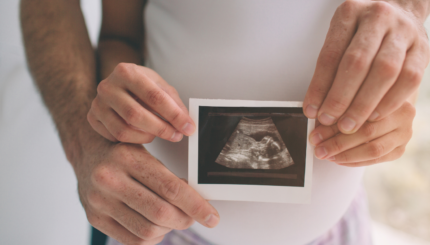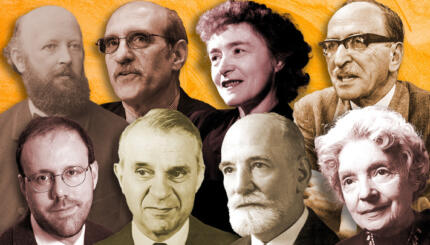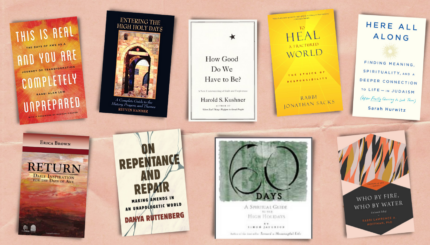For many of the Jewish immigrants who came to the United States in the late 19th and early 20th centuries, the experience of life in a new country was often one of grinding poverty, social exclusion, and the desperate struggle to survive. America was a land of new beginnings, but those beginnings offered no guarantee of a satisfactory conclusion.
Anzia Yezierska was one of the millions to leave Eastern Europe in search of a better life, departing Poland at the age of 15 along with her family and coming to New York in 1898. Yezierska’s family settled on Manhattan’s Lower East Side, where her still-pious father resumed his daily Torah study, and her mother worked to earn money for the family. While her brothers were encouraged in their educations, Anzia was sent to work in a series of sweatshops. Yezierska eventually wangled her way into an undergraduate program at Columbia University without a high-school diploma, pursuing her education against the express wishes of her family. At school, she studied literature and philosophy, and went on to work as a teacher for a number of years. After a brief, failed marriage, Yezierska met the noted scholar John Dewey, with whom she was romantically involved for a number of years, and his encouragement pushed her to try her hand as a writer.
She Begins to Write
Hungry Hearts (1920), Yezierska’s first book, was a collection of stories about people familiar from her own Lower East Side upbringing. Stories like “Hunger” and “The Free Vacation House” summon the indelible, Yiddish-inflected voices of Yezierska’s childhood. “You piece of earth!” a man shouts at his lovelorn niece Shenah Pessah. “Worms should eat you! How long does it take you to wash up the stairs?” Shenah Pessah is the protagonist of three stories in Hungry Hearts, and her arc—from first love to despair, from brutal work to a glimpse of America’s promise—echoes Yezierska’s own, as well as that of future protagonists like Bread Givers’ Sara Smolinsky. “Can I help it what’s in my heart?” pleads Shenah Pessah. “It always longs in me for the higher.”
Hungry Hearts brought Yezierska surprising acclaim, along with an opportunity to work in Hollywood. Samuel Goldwyn bought the film rights to Hungry Hearts, eventually turning it into a well-received movie. Yezierska was briefly hired as a screenwriter, and offered a $100,000 contract by Goldwyn before leaving California and returning to fiction. Her first novel, Salome of the Tenements (1923), took another stab at Yezierska’s favored theme of doomed love between a working-class girl and her well-heeled suitor. It, too, was adapted into a film.

Help us keep Jewish knowledge accessible to millions of people around the world.
Your donation to My Jewish Learning fuels endless journeys of Jewish discovery. With your help, My Jewish Learning can continue to provide nonstop opportunities for learning, connection and growth.
Her masterpiece, Bread Givers (1925), draws on her family history to deftly sketch the clammy sense of entrapment experienced by her hungry–in all senses of the term–protagonist Sara Smolinsky. Sara has three sisters, whereas Yezierska’s family was tutored in American ways by her elder brother Meyer, but the familiar -studying father and the overburdened mother are present once more. Sara, desperate to escape not just the grim Lower East Side but the even grimmer constraints of her family, is indefatigably eager to learn, to grow, and to seize her independence. Bread Givers is propelled by Yezierska’s innate understanding of the rhythms of immigrant speech. “What for will you need old feather beds?” Sara’s father says of their future new home while the family is still in Russia. “Don’t you know it’s always summer in America? And in the new golden country, where milk and honey flow free in the streets, you’ll have new golden dishes to cook in, and not weigh yourself down with your old pots and pans.”
Art in Deseperation
Yezierska’s America is no land of milk and honey, but a brutal place of privation and hand-to-hand combat. Customers plead with pushcart sellers for an extra herring with which to feed their families, tenants beg landlords for an extra day to pay their rent, and fathers hector daughters to keep to the traditional ways, and sacrifice themselves, day by day, to the unending hunger of their parents and siblings. Sara is sent out to work, just as Yezierska had been, and her brute energy is immediately obvious to all: “Give only a look on that little nothing! Only skin and bones—but such quick hands! It burns in her an engine!”
Sara is desperate for those very things in limited supply on the Lower East Side: quiet, cleanliness, and privacy. Bread Givers is a furious blast directed at all those who sought to keep Yezierska silent—not just her family, but the world of  immigrant Jews, and America at large. Sara’s burden is not just that of the immigrant, but that of the Jewish woman, doomed to frustration by the second-class status imposed by religion. The book is ultimately a showdown between two fanatically stubborn individuals, and part of the lingering bittersweetness of Bread Givers is that even in winning, Sara never truly triumphs over her father.
immigrant Jews, and America at large. Sara’s burden is not just that of the immigrant, but that of the Jewish woman, doomed to frustration by the second-class status imposed by religion. The book is ultimately a showdown between two fanatically stubborn individuals, and part of the lingering bittersweetness of Bread Givers is that even in winning, Sara never truly triumphs over her father.
“The prayers of his daughters didn’t count because God didn’t listen to women. Heaven and the next world were only for men,” the book says of Reb Smolinsky’s—and by extension his brand of Judaism’s—views on women. “Only if they cooked for the men, and washed for the men, and didn’t nag or curse the men out of their homes; only if they let the men study the Torah in peace, then, maybe, they could push themselves into Heaven with the men, to wait on them there.”
Yezierska went on writing after Bread Givers, but to a diminishing audience. After All I Could Never Be, in 1932, Yezierska would not publish another book until her autobiography, Red Ribbon on a White Horse, in 1950. Her work largely overlooked by a later generation of readers, seminal books like Bread Givers and Hungry Hearts would be rediscovered by American letters in the 1960s, primed by the re-emergence of Henry Roth’s thematically similar Lower East Side novel Call It Sleep and Yezierska’s pre-feminist consciousness of women’s struggles. In finding her work once again, readers have been able to glimpse the remains of a lost world, carefully and lovingly preserved by a writer who both experienced it, and escaped it.


